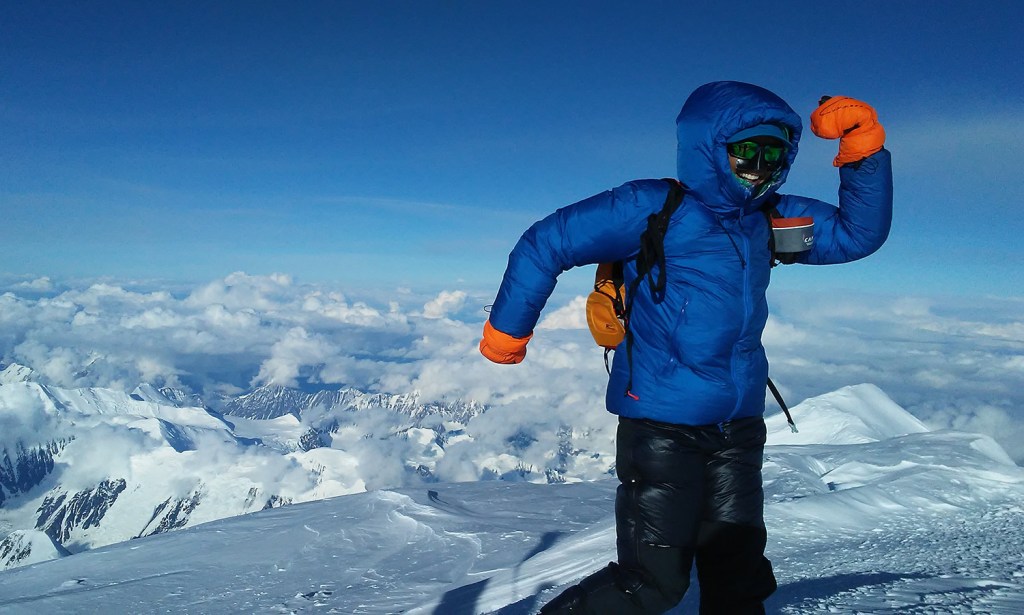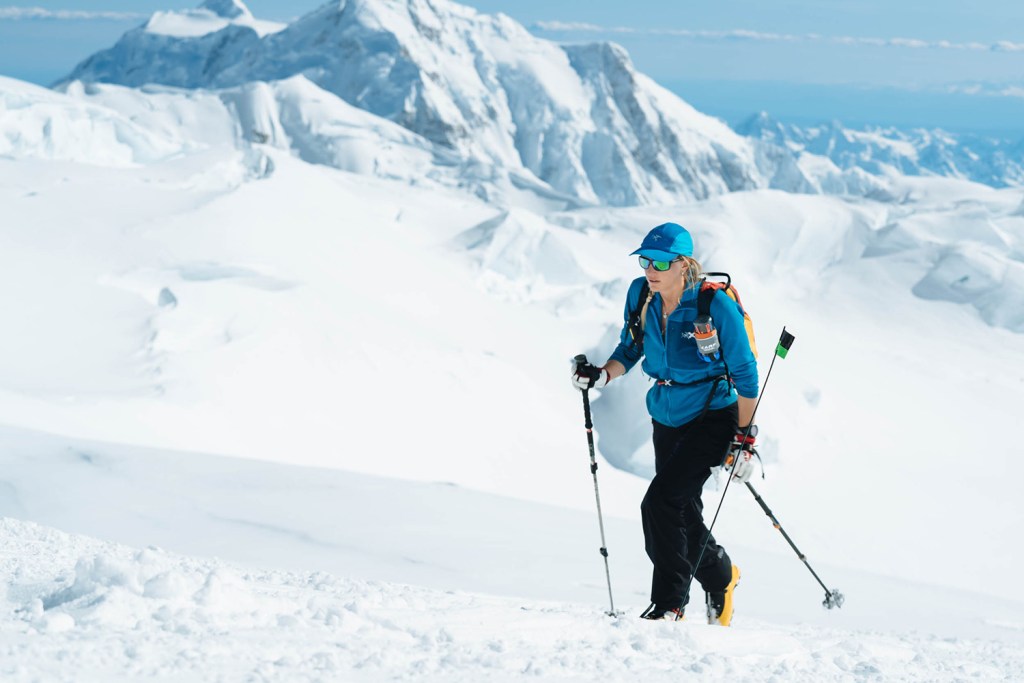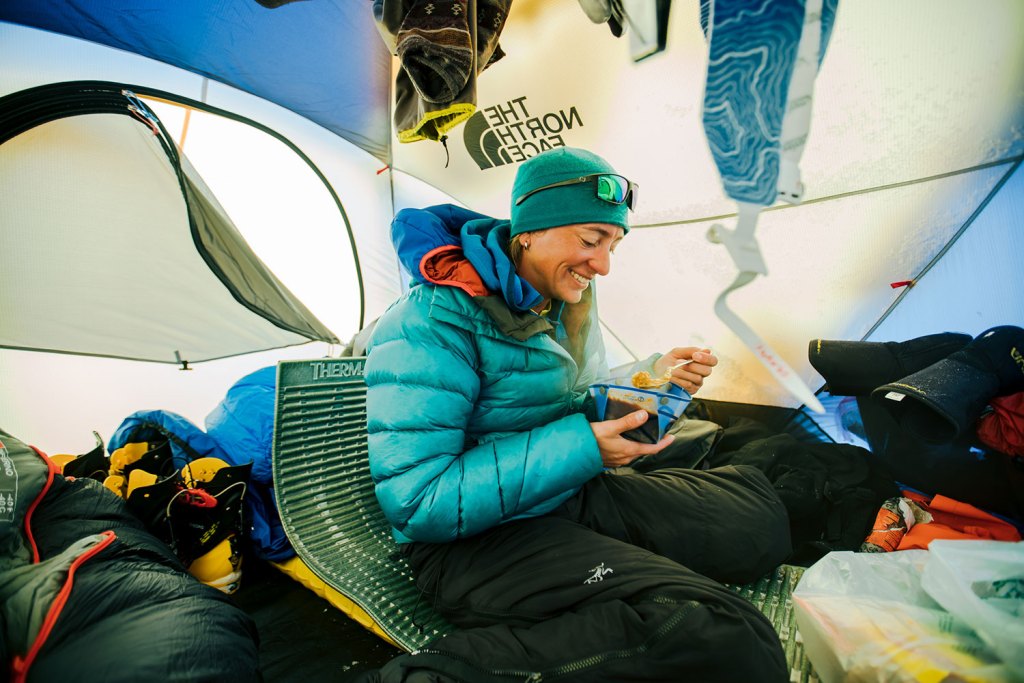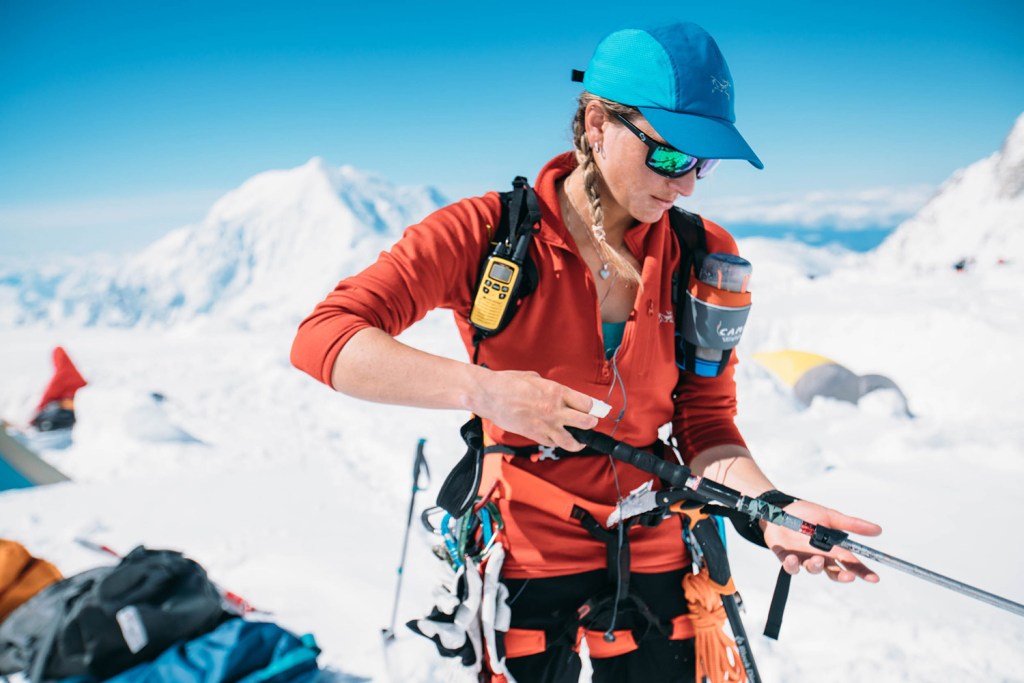A conversation about training, risk, Taylor Swift and sparkly star stickers
Around 8:46 p.m. on June 13, as T-Swizzle vibrated through her earbuds, urging her to “shake it off,” Katie Bono stepped to an elevation of 20,310 feet and slapped some duct tape across her face. She was on the summit of Denali—the highest mountain in North America—in minus 40-degree weather, and her nose had lost feeling about a half hour earlier. She worried it might be frostbitten and the duct tape, she hoped, would keep it warm (and it did keep it from getting worse, she says).
She made a faux-runner pose, and another party snapped a couple photos. And then she charged back down the mountain, beginning a 13,000-foot descent.

Photo: Peter Dale
Katie staggered back into basecamp at 3:00 a.m. the next morning, setting a probable female speed record on Denali, and the third fastest known camp-to-camp time ever. She beat feet from base camp, at 7,200 feet, to the summit of Denali and back in a blistering 21 hours and 6 minutes.
I caught up with her about her achievement as she made her way back to her hometown of Minneapolis, Minnesota, to spend some time with family after her long trip.
How does it feel to be back?
It feels really good. I’m psyched to have some warm weather and go rock climbing, and maybe not do any cardio for a while.
Why was a speed ascent of Denali appealing to you?
I had done a speed ascent on Rainier in 2012, and it was really fun. It’s pretty rare to be able to have the kind of mountain where you can go do what is effectively a giant trail run in really beautiful surroundings, and not have it be incredibly dangerous. I was mountain guiding at the time, and during my first time guiding on Denali, I instantly thought it’d be an amazing mountain to try a speed ascent.

Photo: Savannah Cummins
The terrain is relatively moderate, and there’s a pretty well-trodden trail—or it’s windswept, and you don’t need a trail. This year seemed like a really good year to prepare for it because I didn’t have the time to train for more technical alpine climbing, given I was in school and studying a lot. But I had enough time to do cardio training, and so I figured that I would just make this happen and go for it.
Wait—so you’re in school right now, as well?
I just finished taking the pre-recs to apply for med school. This winter I was taking a couple classes and also studying for the MCAT, so I took that about a month before I left for Alaska. It was kind of the winter of big goals for me. I had to be really, really organized!
What kind of organization did it take to accomplish so much at once?
I had this calendar that I used a bunch of sparkly star stickers to motivate myself with. I would give myself a star if I got in all of my MCAT studying for the day—and I was trying to get about four hours a day. And I got another sticker if I got my workout in for the day. I’m kind of a sucker for stickers!

Photo: Savannah Cummins
What was your most challenging moment up there?
There were a lot of things that were very hard in different ways. I had to sit at basecamp for a week in the rain, and it’s hard to stay psyched and motivated in that. Snow camping in the rain is pretty miserable. And the last 500-800 feet of the speed ascent was hard because I hit the wall. I didn’t pack enough food.
I’m no speed climber, but knowing what I do about crevasses and exposure, I get chills thinking about climbing unroped up there. How did you deal with that risk?
There’s always an element of unpredictability on glaciers. But mostly the way I mitigated the risk is to have spent a lot of time on that type of terrain. I’ve done so much guiding in that environment that I’m really comfortable there. A lot of staying safe is having spent so much time in glaciated, big mountain terrain that I have a pretty solid intuition.
I did attach myself to the fixed lines on the steepest part of the mountain and use them as a backup. If I were to fall and hurt myself or die doing something like a speed ascent, especially when there is protection that you could have used, but decided not to out of pride or something, I would’ve felt really dumb and felt really terrible for my family and friends.

Photo: Savannah Cummins
How did you train?
My training was basically like Nordic skiing training, pretty similar to the stuff in Steve House’s New Alpinism. I did one pretty long ski touring day a week, I did a couple interval sessions per week, and a couple two- to three-hour cross-country skis per week. I started in mid-January, so it was about four months, which wasn’t really enough time. This is the kind of thing where you should be doing endurance training and ski races and running races and sustained training year-round. I used to be a Nordic ski racer, and so I was kind of hoping that I could reactivate my Nordic memory and some endurance base. I would’ve loved to have trained longer, but that’s the time I had, so that’s what I did.
How does a Nordic skiing background translate to this kind of alpinism?
I think what it helps you with the most is just knowing how to suffer for a long period of time in the cold. These pursuits have a lot of parallels for sure.
What was in your pack during your ascent?
Warm clothing, food and water and a little repair tool. My clothing system for something like this is to wear thick, long underwear bottoms and heavyweight softshell pants, then a baselayer, midlayer and down or synthetic shells of various thicknesses. I also had some big down mittens, heavyweight gloves, lightweight gloves and a hat. Then I pack hardshell pants, down pants and duct tape in my pack. Duct tape is versatile. You can put it on your face, and it’ll keep your face warm. I think it’s a Nordic skier trick. There’s a picture floating around on the Internet of me with a big black thing on my face—that’s just duct tape.

Photo: Savannah Cummins
What are your go-to snacks at altitude?
Lara bars. They don’t freeze in the cold. Many other energy bars freeze really hard and become nearly impossible to eat, but Lara bars are the best that I’ve found for severe cold.
I notice you were wearing earbuds. What do you listen to to get psyched?
I was really trying not to get psyched because it was too long of an endeavor to have a lot of emotion swirling. Otherwise, you’d get emotionally exhausted. But I did listen to Taylor Swift the whole way up, and then I listened to Beyoncé on the way down. Taylor Swift is good for taking the edge off, I think.
What do you do when you’re not setting speed records?
Well, there’s med school! And I also like rock climbing and ice climbing and mixed climbing and alpine climbing. And I also play the ukulele, badly. I really wanted to take it on this trip, but I couldn’t handle carrying one more thing.
